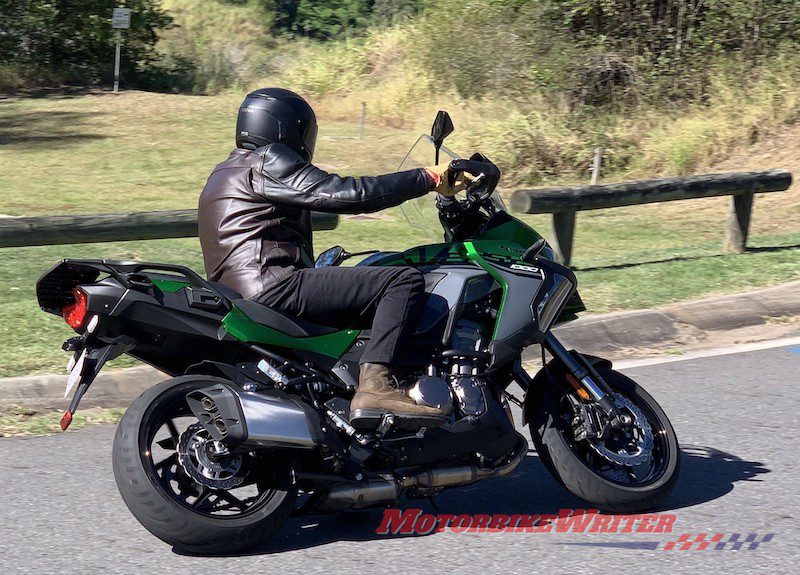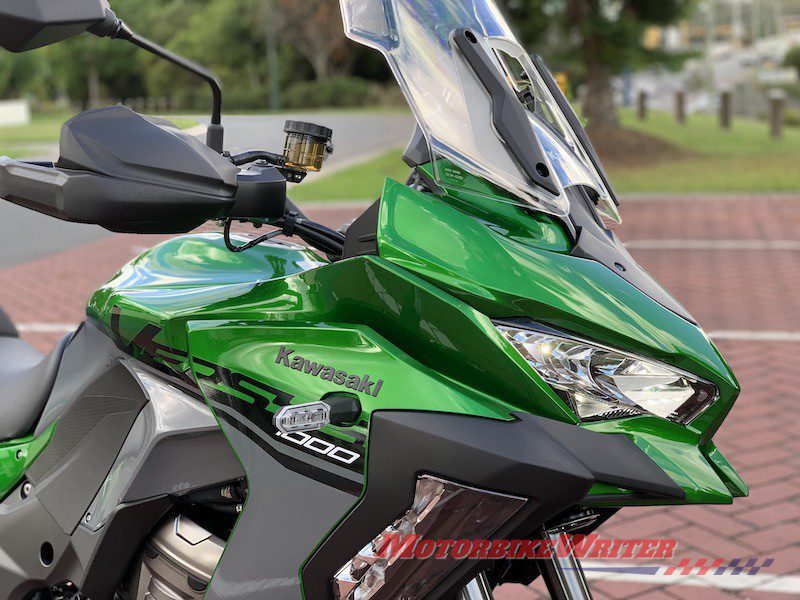The 2019 Kawasaki Versys 1000 SE adds a vast array of electronic aids and wizardry plus ergonomic comforts that make it a truly versatile motorcycle.
While the base Versys 1000 costs $16,100 (ride away based on Brisbane delivery), the SE adds almost $8000. That puts it closer to some European bikes with comparable features.
The SE adds hand guards, cruise control, bigger screen, thicker seats, cornering lights, quick shifter, electronic suspension, TFT colour screen, LED lighting, self-healing paint from the H2, traction control, four engine modes, corner management, inertia control that works on the brakes and traction, and it all Bluetooths to your phone via a special Rideology app.
Whew! It’s a hefty amount of kit but it doesn’t get in the way or feel like extras you don’t really need. They all simply work to make it a competent sports bike, agile commuter and comfy tourer.
SE styling
If you like Transformers, you’re going to love this bike’s styling.
For me, it’s “bitsy” with too many angles and separate plastic panels. There is no flow.
However, Mrs MBW loves it, especially the high-quality sparkling green paint.
It’s also nice to know that any hairline scratches (such as from a tank bag or your belt buckle) can be removed with a blast from a hair dryer or hot sun, thanks to Kawasaki’s clever self-healing paint. Read more here.
If you want to tour, there is no need for extra racks to attach the $1290 lockable hard bags. They simply clip into the “invisible” connectors.
Take them off and there is no ugly scaffolding left behind.
However, you will need to buy a base plate to go on the rear rack if you want to fit a top box.
Engine and transmission
The base and SE models are powered by the 1043cc inline four from the Z1000 which has been detuned for more rideable use.
The word “detuned” might make some riders baulk.
After all, it drops power substantially from 105kW at 10,000 revs in the Z1000 to 88.2kW at 9000 revs while the torque is also down from 111Nm at 7300rpm to 102Nm at 75000rpm.
But the power delivery is more linear, smoother and better controlled by the electronic rider aids which means you can use more of the power and torque more of the time.
What makes it even easier to use is the up and down quick shifter.
It is lightning quick and smooth, allowing you to shift up no matter how much throttle you hold and down-shift on deceleration or a closed throttle, although sometimes I had to take a couple of dabs to get it to change.
On a complex set of corners, you can swap cogs between the turns faster and more frequently than you ever imagined, making for swifter progress.
While the clutch has a light pull, you only need to use it when taking off or coming to a stop.
Over the past couple of weeks that’s the only time I used it.
I found the slick transmission a little under-geared so the engine whined and buzzed some at 4000 revs in sixth gear at 100km/h. Perhaps a taller top cog would be better for touring and economy.
Electronic aids
There are four engine modes that adjust power, the fully adjustable Showa suspension, traction control and braking.
Sport mode gives 100% power and a firm suspension with a bit of latitude in the traction control and ABS.
Road also has full power set, softer settings and less control intervention, while Rain has 75% power, the softest suspension and the most intervention.
Rain is actually a good mode to use around town as it makes the ride-by-wire throttle less snatchy.
Rider mode allows you to fully adjust everything to suit your tastes.
You can switch modes on the fly, or use the Rideology app to set it all up before you ride, then send the settings to your bike.
The app also allows you to record and share your trip which includes a map, plus details such as maximum speed, throttle, brakes and even lean angle.
However, be careful what you record and with whom you share info as you don’t want to incriminate yourself!
Creature features
The riding position of the Versys models is neutral with the rider bolt upright and bars and footpegs a comfortable reach way.
SE adds a bigger, adjustable windscreen with a vent to effectively reduce negative air pressure and annoying turbulence.
In fact, it is so effective, I got quite warm when the temperature nudged mid-20s and on cold days I had to ride with the visor open to prevent fogging.
Together with hand guards and an engine that pours heat out on to your right calf, it would be quite hot in a slow summer traffic crawl.
But in winter it is quite cozy and there is no need for grip warmers as the guards keep the wind chill off the backs of your hands.
SE also gets deeper seat padding. My pillion raved about the rear comfort, the long reach to the pegs and the big grab handles.
However, my bony backside found the firm, contoured seat prevented me moving around, so I developed “hot spots” on my rear after about an hour.
I’m 183cm tall and I couldn’t get my heels on the ground thanks to the high 840mm seats, so it’s not for short riders.
The easy-lift centre stand is a breeze to use and convenient for cleaning the rear wheel and chain maintenance.
Tech features
TFT screens are amazingly clear in all lighting conditions and allow a host of information.
This customisable screen is no different and Kawasaki have packed in a wide array of features.
Some information is more for entertainment value and could even be a distraction.
For example, you can select one screen variant that shows dynamic throttle position, braking effort and lean angle.
Those could be interesting stats on your Rideology app to show your friends after your ride. However, they would be a distraction on the fly, particularly checking out your lean angles as you are cornering!
With all these creature features, I was surprised Kawasaki did not add self-cancelling indicators. I believe they should be mandatory on all road bikes as they are a safety measure and have been in cars for decades.
Handling
All the electronics and creature features only add 7kg to the weight of the SE which at 257kg might seem a bit porky.
However, it feels light even lifting it off the side stand and turning it around in my garage.
It feels lighter as you get under way.
Change of direction is super light, making it eminently manoeuvrable in a carpark, around tight roundabouts, carving the S-bends on your favourite mountain road or filtering through the morning traffic.
Wide tapered-steel handlebars amplify the flickable nature of the SE.
Yet for all that quick steering and nimble handling it feels very stable on the highway.
It also holds a sturdy line through corners while allowing you to adjust your line without disturbing the bike’s balance.
The 43mm inverted Showa cartridge forks and Showa BFRC lite rear shock are fully adjustable through the electronic settings, although you need a 5mm hex key to adjust front preload.
I found the Sport setting a little too stiff for our country roads.
Most of my ride time was spent in the Road setting, although the Rain mode actually provided the swiftest progress through the corrugated corners on the western side of Mt Glorious.
Rain mode is also super-plush for touring and should allow most people to sit comfortably for the full duration of the almost high-300km range you could squeeze from the 21-litre tank.
You can also set up the suspension to account for your load from the options of Rider, Rider and Luggage, or Rider with Passenger and Luggage.
There is no setting for rider and pillion without luggage, so I set it to rider and luggage where it worked just fine. In fact, I could hardly feel my pillion on the back.
Above and beyond whatever suspension settings you choose, the dynamic damping electronically adjusts for road irregularities in milliseconds to iron out bumps and keep the rubber on the road.
The Bosch IMU works so well with the traction and brake controls that you can be a little hamfisted with throttle and brake application without drama, even when leaned over in a corner.
Conclusion
You may not like all the electronic wizardry, but in this case it all works to provide a dynamic, yet comfortable ride.
It also converts this into a versatile three-in-one bike that makes the extra expense worthwhile.
Kawasaki Versys 1000 SE tech specs
| Model |
KLZ1000DKF |
|
|
Engine Type |
1043cc in-line 4-cylinder, liquid- cooled. |
|
| Price | $24,000 (ride away in Brisbane) | |
|
Bore x Stroke |
77 x 56mm |
|
|
Compression Ratio |
10.3:1 |
|
|
Valve System |
DOHC 16 valve |
|
|
Fuel System |
DFI 4 X 38 mm with oval sub throttles |
|
|
Ignition |
TCBI with Digital Advance |
|
|
Starting |
Electric |
|
|
Transmission |
6-speed with Positive Neutral finder |
|
|
Suspension – front |
43mm inverted forks with KECS-controlled compression and rebound damping, manual spring preload adjustability, and top-out springs |
|
|
Suspension – rear |
Horizontal Back-link, BFRC lite gas-charged shock with piggyback reservoir, KECS-controlled compression and rebound damping, and electronic spring preload adjustability |
|
|
Wheel travel – f/r |
150/152mm |
|
|
Clearance |
150mm |
|
|
Brakes – front |
Dual semi-floating 310mm petal discs, Dual radial-mount, opposed 4-pistons with ABS |
|
|
Brakes – rear |
Single 250mm petal disc, single-bore pin-slide, aluminium piston with ABS |
|
|
Wheel Size Front Rear |
3.50-17.0 5.50-17.0 |
|
|
Tyre Size-front rear |
120/70ZR17M/C (58W) 180/55ZR17M/C (73W) |
|
|
L x W x H |
2270 x 950 x 1490-1530mm |
|
|
Wheelbase |
1520mm |
|
|
Seat height |
840mm |
|
|
Fuel capacity |
21 litres |
|
|
Curb Mass |
257kg |
|
|
Max Power |
88.2kW (120hp) @ 9000rpm |
|
|
Max Torque |
102Nm @ 7500rpm |
|
|
Colour/s |
Emerald Blazed Green with Pearl Storm Gray |
|
|
Warranty |
2 years, unlimited km |













